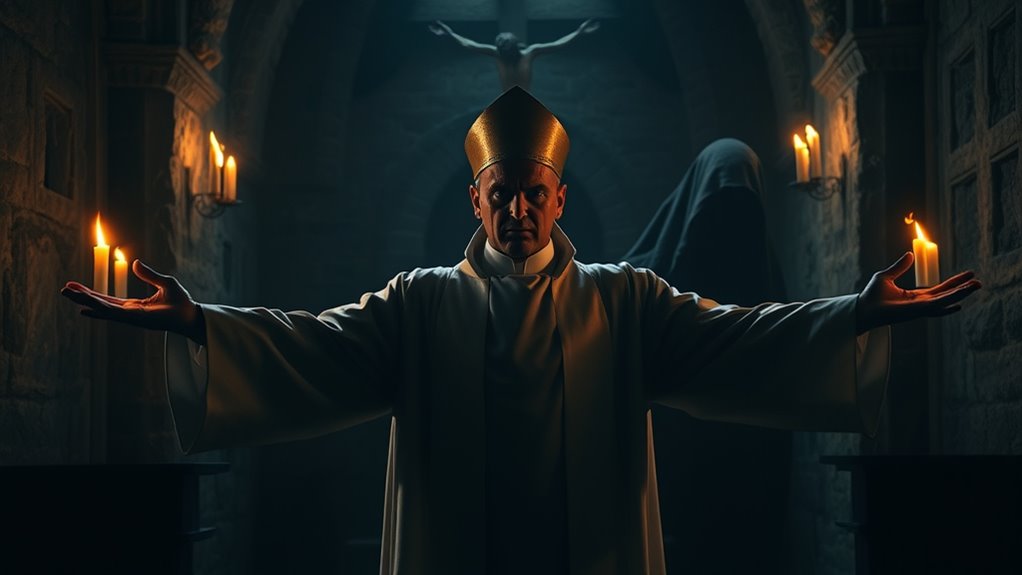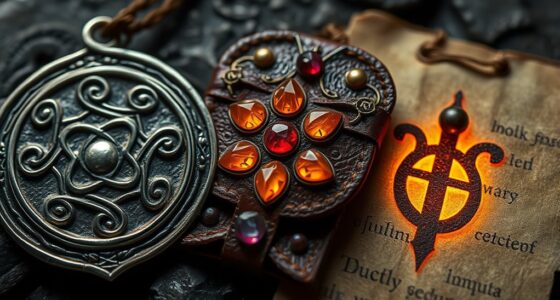In the Exorcist’s Rite, you see that exorcisms use sacred objects, prayers, and divine authority to expel demons. Rituals are carefully prepared in a sacred space, incorporating symbols like crosses and holy water to focus spiritual power. During the process, prayers and scripture are recited, and commands are issued to confront the demon. If you’d like to understand how faith and symbolism play a role throughout, there’s more to uncover about these ancient spiritual practices.
Key Takeaways
- The rite involves prayers, scripture readings, and commands to confront and banish the demon through divine authority.
- Sacred objects like crosses, holy water, and relics are used to invoke divine power and reinforce spiritual protection.
- Rituals are performed in a sacred, quiet environment to focus spiritual energy and reduce fear.
- The exorcist’s faith and spiritual authority are essential for successfully expelling the demon.
- Multiple sessions may be required, with signs of resistance indicating ongoing spiritual confrontation.
Historical Origins and Development of Exorcism Rituals

Exorcism rituals have ancient roots that trace back thousands of years, reflecting humanity’s long-standing belief in spiritual forces and the need to confront evil. Ancient texts from civilizations like Mesopotamia, Egypt, and Greece document early practices aimed at banishing malevolent spirits. These writings reveal how cultures developed their own methods, often blending religious rites with symbolic acts. Cultural influences profoundly shaped these rituals, adapting them to local beliefs and spiritual hierarchies. For example, the Hebrew Bible contains references to exorcism, while Roman and Greek traditions incorporated sacred prayers and incantations. Over centuries, these practices evolved, influenced by religious leaders and societal shifts, laying the foundation for modern exorcisms. Understanding these origins helps you see how diverse cultures sought to combat unseen evil forces throughout history. Additionally, the cultural context of each society played a crucial role in shaping the specific rituals and beliefs surrounding exorcism practices. The development of ritual symbolism further illustrates how spiritual and cultural elements intertwined to create meaningful exorcism ceremonies. Furthermore, historical accounts reveal that many rituals incorporated sacred objects believed to hold protective or purifying powers, emphasizing the tangible connection between physical items and spiritual efficacy.
The Preparation and Setting for an Exorcism
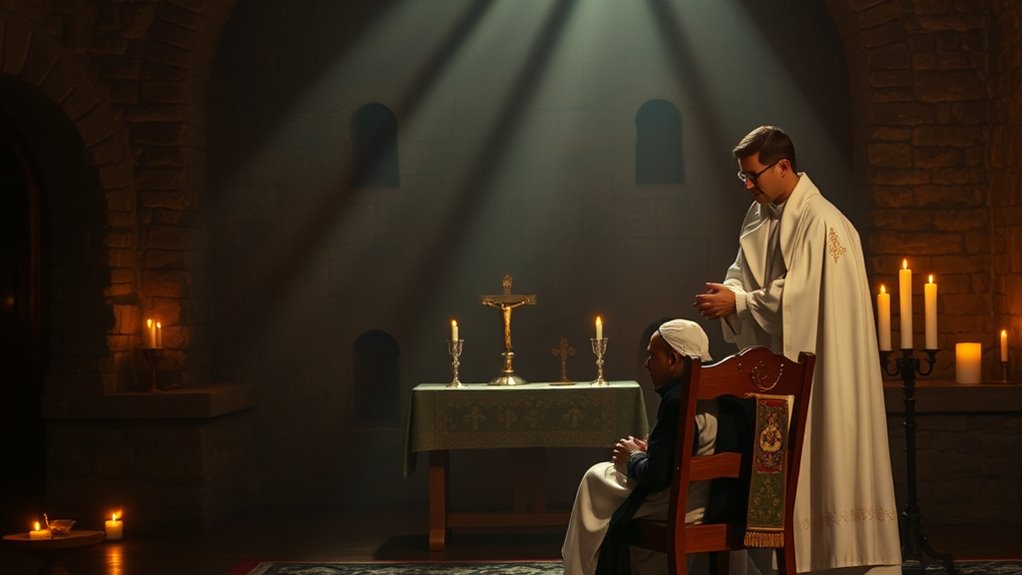
Building the right environment is essential before performing an exorcism, ensuring that both you and the setting are prepared for the intense spiritual work ahead. You should carefully assess the psychological impact on everyone involved, providing support and reassurance to lessen fear or anxiety. You can also consider incorporating self watering plant pots to create a calming atmosphere through natural greenery, which can help ease tension. It’s important to recognize cultural variations, as different traditions may have specific rituals or symbols to create a sacred space. You’ll want a quiet, secure area free from distractions, often with religious artifacts or icons to establish spiritual authority. Proper preparation also involves prayer, blessings, and mental focus to align your intent. Additionally, understanding the contrast ratio of your environment can influence the overall ambiance, helping to create a setting conducive to spiritual work. Creating a focused environment is vital, as sustained attention can significantly enhance the effectiveness of the ritual. By setting a respectful, protected environment, you help facilitate the ritual’s effectiveness while minimizing emotional or spiritual disturbances during the exorcism. Incorporating accurate tools and preparations can further enhance the safety and efficacy of the ritual.
Key Elements and Symbols in the Ritual

You’ll notice that sacred symbols and ritual objects play an essential role in the exorcism process. These elements are believed to carry spiritual power and help focus the priest’s authority. Understanding their significance can deepen your appreciation of how the ritual works. For example, consecration in the Bible often involves prayer, anointing, and dedication ceremonies that set apart objects and spaces for sacred use. Additionally, the use of holy relics such as crosses, holy water, and crucifixes reinforces the spiritual authority invoked during the ritual. The significance of animated movies and their emotional themes can sometimes mirror the transformative power of faith and ritual practices, highlighting universal stories of overcoming darkness. These symbols are often blessed and imbued with spiritual energy to enhance their efficacy during exorcisms. Unplanned weather changes can sometimes lead to comical outcomes, adding an unexpected element to these solemn ceremonies.
Sacred Ritual Symbols
What are the key symbols that imbue an exorcism with its sacred power? You’ll find that demon symbolism plays an essential role in the ritual, representing the evil force you aim to banish. These symbols serve as visual cues that reinforce the spiritual authority of the exorcist and the sacredness of the rite. Ritual craftsmanship is crucial; every element—from the placement of symbols to the way they’re invoked—demonstrates careful preparation and intentionality. These sacred symbols, whether crosses, holy water, or specific gestures, act as conduits of divine power, helping to focus spiritual energy. Additionally, understanding the cultural significance of symbols used in different traditions can deepen the effectiveness of the exorcism. For example, the use of specific ritual gestures can invoke divine authority more powerfully when performed with precision and reverence. Incorporating knowledge of dog breeds and their symbolic meanings can also enhance the spiritual symbolism in some rituals, emphasizing purity and protection. Together, demon symbolism and ritual craftsmanship elevate the exorcism, transforming it into a potent act of spiritual warfare.
Ritual Object Significance
Ritual objects are essential elements that carry deep symbolic and spiritual significance during an exorcism, serving as tangible conduits of divine power. These objects embody the ritual’s sacred purpose, enhancing its ritual significance and focus. For example, crucifixes symbolize Christ’s victory over evil and invoke divine authority. Holy water is believed to possess cleansing and protective qualities, amplifying the symbolic power of the ritual. Candles represent light overcoming darkness, reinforcing spiritual strength. Each object is carefully chosen to reinforce faith, channel divine energy, and establish a sacred space. Their presence not only underscores the gravity of the ritual but also helps direct spiritual forces, making the exorcism more effective. In this way, ritual objects serve as powerful symbols that bridge the physical and spiritual domains during the rite.
The Role of Prayer, Scripture, and Holy Objects
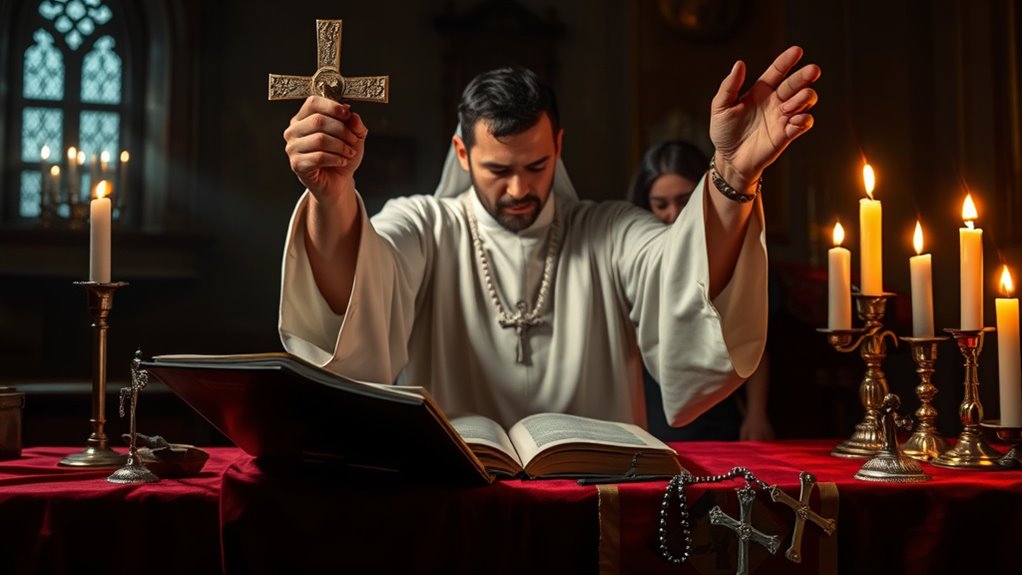
Prayer, Scripture, and Holy Objects play an essential role in exorcisms by creating a sacred space and reinforcing spiritual authority. You use prayer to invoke divine power, guiding the process of spiritual cleansing and faith healing. Scripture acts as a spiritual weapon, reaffirming God’s authority and driving out evil influences. Holy objects, like crosses or relics, serve as tangible symbols of faith, helping establish God’s presence and protection. Together, these elements focus the exorcist’s intent, build a spiritual barrier, and deepen the connection to divine help. They remind everyone involved that the battle is ultimately spiritual, not physical. By integrating prayer, Scripture, and holy objects, you strengthen your spiritual authority, making the exorcism more effective in expelling the demon.
The Process of Exorcism: What Typically Happens
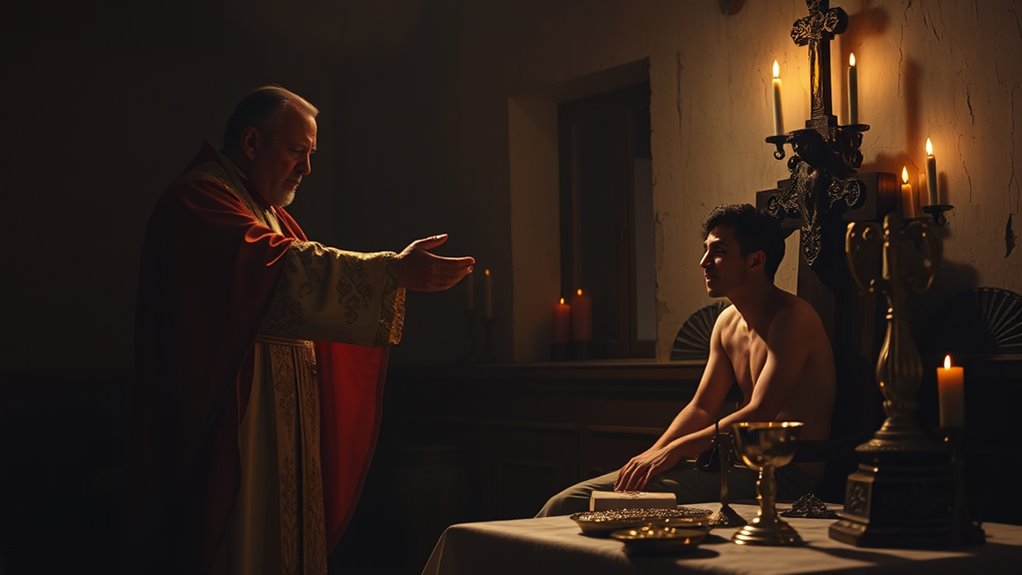
The exorcism process unfolds through a series of structured steps designed to confront and remove the demon. First, the priest assesses the situation, looking for signs of demon possession. During the initial exorcism stages, he recites prayers, scripture, and commands to command the demon to leave. You might observe physical signs or resistance as the demon fights to stay. The priest might use holy objects and invoke God’s power to strengthen the ritual. The process can be repeated over multiple sessions, gradually breaking the demon’s hold. Throughout, the focus remains on spiritual authority and faith, aiming to expel the demon completely. Every step is carefully performed to ensure the safety of the person and the effectiveness of the exorcism.
Beliefs About How Demons Are Expelled and Aftereffects
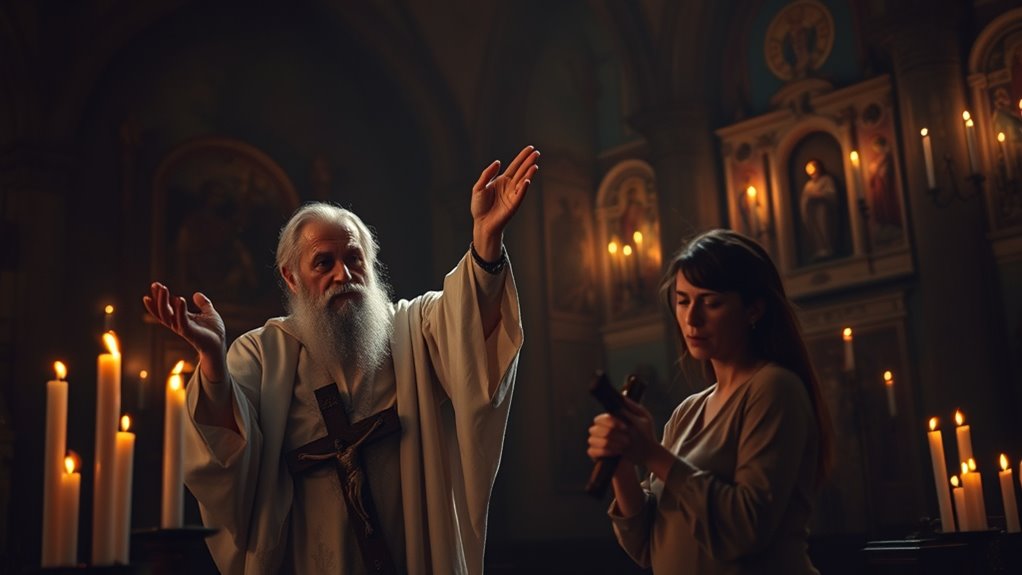
Many believe that demons are expelled through the intense power of faith, prayer, and divine authority, which are seen as crucial to overcoming demonic possession. During an exorcism, spiritual cleansing is performed to rid the individual of evil spirits, restoring spiritual harmony. The belief is that these rituals break the demon’s hold, allowing it to leave the person’s body. Aftereffects can vary; some feel immediate relief, while others experience emotional or physical exhaustion. Many think that successful exorcisms restore peace and spiritual purity, but skeptics see them as symbolic acts. Ultimately, the core idea is that faith and divine power are essential tools for expelling demons and healing those affected by demonic possession.
Frequently Asked Questions
How Do Exorcists Determine if a Possession Is Genuine?
You might wonder how exorcists determine if a possession is genuine. They look for demonic indicators like supernatural strength or aversion to holy objects. They also rely on spiritual criteria such as the victim’s resistance to prayer or signs of altered behavior. By carefully observing these signs, exorcists assess whether the evidence aligns with demonic influence, helping them decide if a true possession is present before proceeding with an exorcism.
Are Exorcisms Performed Differently Across Various Religious Traditions?
You might notice that exorcisms differ across religious traditions, reflecting cultural variations and ritual differences. In some faiths, exorcisms involve elaborate prayers and symbolic acts, while others emphasize simple prayers and blessings. You see these differences in the words spoken, the rituals performed, and the objects used. Despite these variations, the core intention remains the same: to confront and expel the entity, uniting tradition and faith in a powerful act of spiritual cleansing.
What Safeguards Are in Place to Protect Those Involved in Exorcisms?
You’re right to wonder about safeguards during exorcisms. Spiritual safeguards like prayer, scripture, and protective rituals help shield everyone involved. Safety protocols, including thorough assessment, trained exorcists, and controlled environments, are in place to prevent harm. These measures ensure the process remains focused on spiritual healing rather than physical danger, giving you peace of mind that everyone’s well-being is prioritized throughout the exorcism.
Can Exorcisms Be Performed Remotely or Only in Person?
Think of exorcisms like casting a powerful spell—most require you to be physically present, like a wizard in their sacred space. Remote procedures and virtual exorcisms are rare and controversial, relying on technology to channel spiritual authority across distances. While some believe in the effectiveness of virtual exorcisms, many insist that true power comes from face-to-face rituals, where the sacred and the tangible intertwine, making in-person exorcisms the norm.
What Are the Psychological Effects on the Exorcist During and After the Ritual?
During and after performing an exorcism, you might experience psychological trauma from intense emotional and spiritual challenges. It can shake your emotional resilience, leaving feelings of fear, doubt, or exhaustion. You need to stay grounded and seek support to process these experiences. Staying aware of your mental health helps you maintain resilience, ensuring you’re prepared for the emotional toll and can recover well after the ritual ends.
Conclusion
While some may doubt the effectiveness of exorcisms, many believe these rituals hold spiritual power beyond physical explanation. By respecting centuries of tradition and faith, you can appreciate how these rites aim to free individuals from darkness. Whether or not you accept the supernatural, understanding the ritual’s symbolic significance offers insight into humanity’s enduring struggle against unseen forces. Ultimately, it’s a affirmation to the enduring human desire for spiritual liberation and protection.
